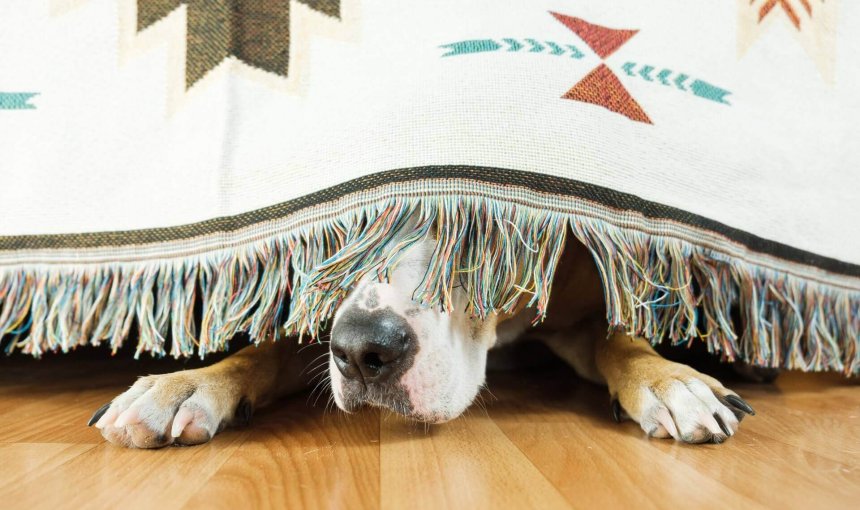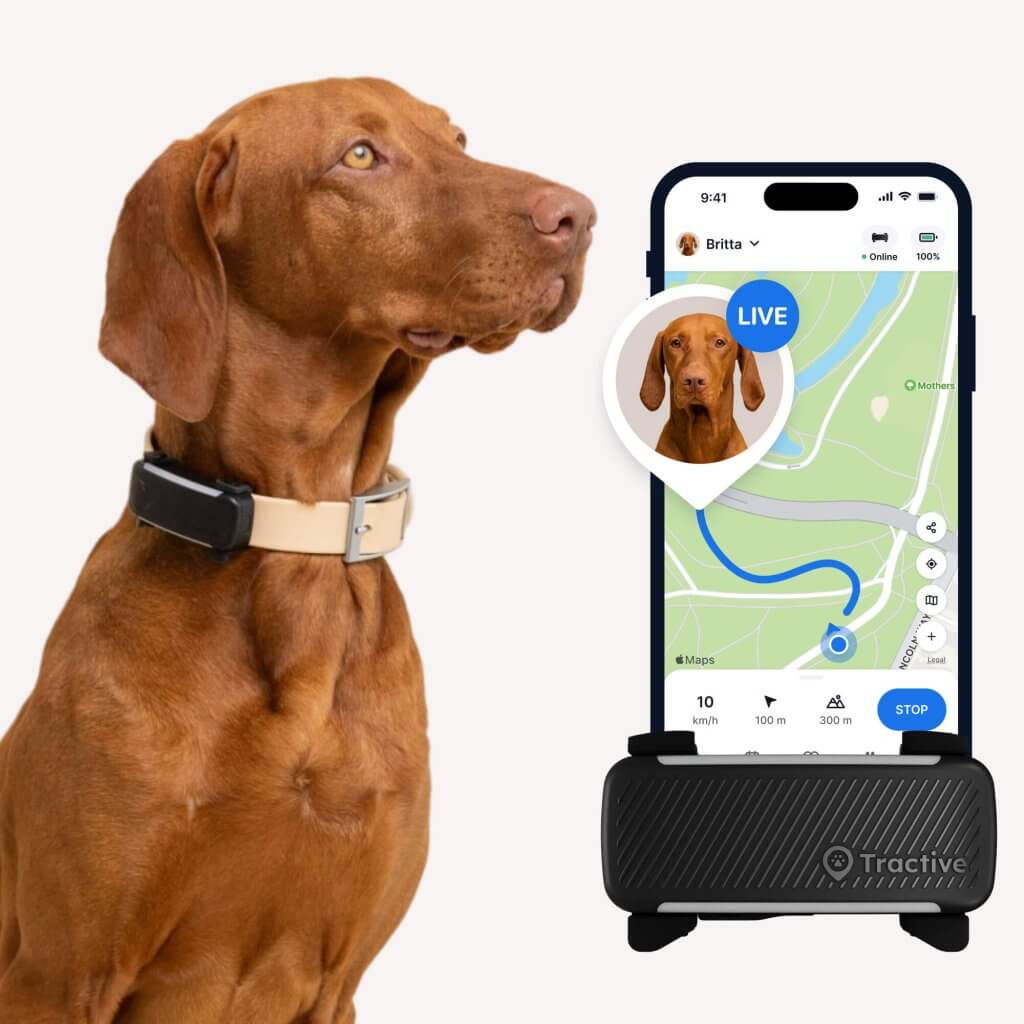Why Is My Dog Hiding? 11 Reasons Behind It
Much like cats, dogs also hide for different reasons - some benign, others more serious. Here's everything you need to know about why your dog is hiding from you.

Maybe your dog has a habit of hiding – or maybe this is a new behavior that started all of a sudden. It turns out, dogs hide themselves for a lot of reasons, ranging from harmless to potentially serious. Let’s explore why dogs hide, plus how you can keep track of them (and their wellbeing) at all times.
Key Takeaways
- Hiding can be a harmless habit or a sign of a deeper issue. Keep an eye out for your dog’s behavior and don’t ignore any weird changes.
- The more harmless reasons for a dog hiding could be wanting a safe space, hiding their favorite items, or wanting to stay cool (or warm.)
- More serious reasons include age-related health problems, fear, stress, anxiety, or even illness.
- A smart dog tracker like Tractive can help you spot potential health issues early – and, in an emergency, even locate your dog if they’re hiding indoors.

Always know your buddy is healthy & safe
Read moreWhy is my dog hiding? 4 harmless reasons
When dogs hide – it could be normal behavior, or a cause for concern. So it’s important to know the difference and spot changes in your furry friend’s routines. Here are some harmless reasons why dogs hide.
They love a safe space
Just like us, dogs often need a cozy spot to rest and recharge. A quiet, dark, and comfortable corner of the house – maybe under your bed – might be just what they need for a few hours of down time. If you’re not a fan of your dogs chosen hiding spots – try recreating a similar, dark, cozy environment elsewhere – like in their crate or kennel. Or keep their dog bed in a quiet corner where they can have a little privacy.
They need a place to hide their stash
“Why does my dog hide under the bed?” is a valid question. But along with that should be: “What is my dog hiding under the bed?” Whether it’s treats, toys, socks, or more, your dog might hide in different spots around your home to protect their “treasures”. For example, they might have picked up a treat someone dropped on the floor. Or found an unusual-looking mushroom outdoors and brought it back home for inspection. Dogs also tend to be territorial. So their “cave of treasures” might be their way to claim a space that’s theirs alone in your house.
They’re looking for something
Another reason why dogs may seem to hide is that they’re looking for something – like tasty table scraps or a toy or a favorite blanket. Searching for food or other little treasures might lead your dog to get into some secret hiding spots you didn’t even know about – indoors or outside.
They’re warming up – or cooling down
Dogs can naturally regulate their body temperature – when it’s warm or cold outside. Still, you might find them hiding under your bed to warm up during winter months. Or when it’s hot outdoors, you might find them lying on a cool floor for a bit of relief.
For more tips on keeping your dog warm in winter check out our other post on dogs & cold weather. Or find out how to keep your dog cool in summer.
7 concerning reasons your dog might be hiding
They’re getting older
Senior dogs might experience a decline in their senses as they grow older, like their vision or hearing. This can make them feel disoriented and vulnerable. Seeking out a quiet, dark hiding spot is their way of retreating from a world that has become confusing or overwhelming.
In some cases, hiding can also be a symptom of cognitive dysfunction, often referred to as “dog dementia.” Senior dogs with cognitive issues may become anxious or confused, hiding in unusual places or getting “stuck” in a corner. These behaviors can be a sign that their cognitive abilities are declining and they’re struggling to navigate their environment. If you notice your senior dog hiding more often, especially in conjunction with other signs of aging or disorientation, talk to your vet to rule out any underlying health issues.
Read More:
They’re frightened
Dogs often hide simply because they’re afraid of something. Loud noises like thunderstorms or fireworks can easily turn your normally calm dog into a fearful dog that runs into hiding. But they could also be afraid of something else – a new pet in the home, a strange smell, or new plush toy. A lot of things could make our dogs feel scared. The important thing is to recognize what’s causing them fear and help them feel safe again.
They’re feeling stressed
Much like cats, dogs tend to get thrown off balance when there’s a big change in their environment. Changes like new humans, pets, neighbors, construction in your neighborhood, or switching homes can all be stressful for them. Once you’ve figured out the cause of stress, make sure to bring some routine and familiarity back to your home. Set a regular schedule for feeding, walking, and playtime together. Spend some quality time with your buddy and help them remember they’re still your favorite. Prioritize regular exercise and ensure your dog is getting enough outdoors time. (Staying indoors can actually make them feel bored and agitated instead.)
They’re sick
The signs of illness in dogs aren’t always obvious. But hiding is one sign your dog may be sick. Much like cats, dogs also tend to mask their pain and discomfort. So it can be easy to miss out on the signs they’re struggling with an illness, injury or infection until it’s too late.
If your dog’s hiding isn’t a normal behavior, or if they’re showing other signs of illness like lethargy or not eating, it may be time to go to the vet. Like these Reddit users found:
- “My dog started (hiding) when he came down with secondary glaucoma in one eye.” —1boatinthewater
- “My dog used to hide when he would have seizures.” —Pawseverywhere
- “A few months ago my mom mentioned her dog wasn’t sleeping in bed with her anymore. She thought because she was small and older (10) she was getting hurt. Then she didn’t want to go outside. Then she wasn’t eating much. We ended up finding out too late that she was diabetic and it was suggested she had diabetic ketoacidosis. But it was too late and she was too sick.” —coffeedoodle
💡 A Tractive smart dog tracker can help you spot potential health red flags early. It’ll notify you if your dog’s activity or sleep patterns change and help you spot a change in their vital signs. (Like their breathing and heart rate.) Better yet, you can also use your tracker’s short range Bluetooth features to locate your dog if they’re hiding indoors!
They’re injured
Speaking of pain – another reason why your dog may hide is if they’ve been injured. If you suspect this could be the reason for your dog taking cover all of a sudden, inspect them for wounds or injuries. Or to be safe, take them to the vet.
Read More: All The Signs Of Pain In Dogs & What You Might Miss
They have anxiety
Hiding is a way to help dogs escape threats and feel safe. In some cases, they can also develop separation anxiety. This is when your dog feels excessively distressed at the thought of you leaving. Which is why you might find them hiding under your bed, which has your scent – to provide them a sense of safety. Dogs are also vulnerable to trauma – especially if they’ve experienced abuse in the past. As a result, they may have learned to associate certain situations or people with danger.
They’re pregnant
Lastly, another reason for a female dog hiding is: (surprise!?) they’re pregnant. In the last weeks of pregnancy, dogs may show ‘nesting’ behaviors and seek out a quiet safe spot to give birth. If you suspect your dog may be pregnant, its best to have the vet check her out. Your vet will be able to tell you if your pup is really pregnant.
Where a smart dog tracker can help
A smart dog tracker can be a valuable tool for dog parents to understand and address their dog’s hiding behavior. Tractive, for example, offers a range of features that can help you both get to the root of the issue and locate your furry friend when they’re hiding.
For example, if your dog is hiding because…
They’re sick
One of the first and easiest to miss signs your dog is sick if they’re less active than usual. (Or not sleeping as well as they should.) With your tracker’s built-in motion detector, you can monitor changes in their activity levels and sleep quality. If there’s a weird change in either of these, you’ll get a Health Alert – prompting you to get your dog checked up at the vet.
They miss you
Hiding can also be a sign of emotional distress, including separation anxiety. Your Tractive tracker comes with a built-in Bark Monitor and Separation Anxiety Monitor that can alert you to signs of stress when you’re not home, such as excessive barking or pacing. So you can drop by on your lunch break to say hi or get someone to check up on them.
They’ve gotten stuck somewhere
Finally, if your dog has found a new favorite hiding spot and you can’t find them, your tracker can help you locate them – even while indoors. While real-time GPS tracking is great for outdoors, indoor hiding spots can be tricky. The Tractive tracker offers close-range locating tools like Bluetooth, Light & Sound tracking, and even Augmented Reality to guide you directly to your dog, no matter where they’ve decided to burrow.
The bottom line on hiding dogs
Dogs hide for a number of reasons, some of which can be a cause for concern. Other times, they just want to snuggle up next to your socks under the bed. Always pay attention to your dog’s behavior and take them to the vet if you suspect they could be sick or injured. Otherwise, they may just need a little extra love and care.




